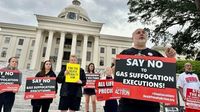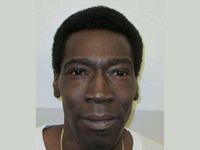In a decision that has reignited debate over capital punishment and the ethics of execution methods, Alabama Governor Kay Ivey has scheduled the execution of Anthony Todd Boyd for October 23, 2025, with the process to be carried out using nitrogen hypoxia. The announcement, made on August 18, 2025, marks Boyd as the third man set for execution in Alabama within a three-month span, and places the state’s controversial nitrogen gas protocol back into the national spotlight.
Boyd, now 53, has been on Alabama’s death row since 1995. He was convicted of the 1993 murder of Gregory Huguley, a man who, according to court documents and Associated Press reports, owed Boyd and three other men $200 for cocaine. The details of the crime, as revealed in court records, are harrowing: Huguley was kidnapped at gunpoint off a street in Anniston, Alabama, taken to a rural baseball field in the Munford community, bound with duct tape, and taped to a park bench. The men then doused him with gasoline and set him on fire, resulting in his death. Huguley’s burned body was discovered on August 1, 1993, in Talladega County.
Boyd’s conviction came after a jury found him guilty of capital murder during a kidnapping, recommending the death penalty by a 10-2 vote. While prosecutors painted Boyd as a central figure in the crime, a trial witness—testifying as part of a plea bargain—stated that Boyd taped Huguley’s feet before another man, Shawn Ingram, poured the gasoline and ignited the fire. Boyd’s defense team, however, maintained throughout the trial that he was at a party the night of the murder and did not participate in the killing. Despite these claims, Boyd was sentenced to death, while his co-defendants received varying sentences: Ingram was also convicted of capital murder and remains on death row, Moneek Ackles was sentenced to life without parole, and Quintay Cox pleaded guilty to a lesser charge and was sentenced to life with the possibility of parole.
Since his conviction, Boyd has challenged his death sentence through multiple legal avenues. In 2017, he requested to be executed by hanging or firing squad rather than by lethal injection, which, at the time, was one of only two approved execution methods in Alabama (the other being electrocution). The 11th U.S. Circuit Court of Appeals rejected his appeal, and the U.S. Supreme Court denied his writ of certiorari in 2018. That same year, Alabama allowed death row inmates to select nitrogen hypoxia as their method of execution, and Boyd opted for this newly available procedure, even though the state had yet to develop the operational protocols for its use.
Fast forward to 2025, and Alabama has now used nitrogen gas to carry out five executions, with another planned for September, according to the Associated Press. The method, which involves replacing breathable air with pure nitrogen delivered through a gas mask, causes death by oxygen deprivation. Alabama was the first state to use nitrogen hypoxia for executions, beginning with Kenneth Eugene Smith in January 2024; Louisiana has since used the method once as well.
However, the use of nitrogen hypoxia has drawn sharp criticism from opponents, who argue the method is untested, unconstitutional, and amounts to torture. Boyd himself, despite having selected nitrogen hypoxia in 2018, is now challenging its use in federal court, arguing that it may be unconstitutionally cruel—especially given his asthma and vertigo. He contends that the state’s heavily redacted execution protocol leaves critical questions unanswered, including who is responsible for key steps and what training they possess. In his lawsuit, Boyd’s lawyers cited reports that previous inmates executed by nitrogen gas showed “signs of conscious suffocation, terror, and pain.” They wrote, “The consistency and commonality of these observations across multiple sources rules out the possibility of isolated observer bias, supporting the conclusion that elements of suffocation are inherent to the Protocol.”
Adding to the controversy, the lawsuit points out that nitrogen gas has been banned for euthanizing dogs in some jurisdictions, raising further ethical concerns. Boyd’s legal team also argues that the process could leave an inmate brain damaged but still alive, particularly in cases where the person suffers from respiratory conditions like asthma. As part of legal procedure, Boyd has been required to propose feasible alternative execution methods, suggesting firing squad, hanging, or medical aid-in-dying. State prosecutors, however, have dismissed these alternatives, calling the hanging suggestion “unserious” and arguing that there is “no reason to infer that everything in a firing execution will work properly or that remaining conscious with one or more gunshot wounds is significantly less painful than death by nitrogen hypoxia.”
The Alabama Attorney General’s Office, for its part, has maintained that nitrogen hypoxia is a humane method, causing loss of consciousness within seconds. In court filings, they argued that described movements during previous executions were either inmates actively resisting or “involuntary movements associated with dying.” The office also accused Boyd of using his lawsuit as a delay tactic, noting that he elected nitrogen hypoxia in 2018 yet did not file suit until years later. “There is no good explanation other than the machinations of an inmate less concerned with the legitimacy of his claims than with throwing a spanner into the State’s execution process,” the office wrote.
Meanwhile, the ethical debate has been further fueled by firsthand accounts. The Rev. Jeff Hood, a spiritual adviser who witnessed the first nitrogen execution and is now working with Boyd, said he was “horrified” by what he saw, describing the death as being “suffocated to death.” Boyd’s lawyers echoed these sentiments, writing, “Each prisoner previously executed by the State’s Protocol showed signs of conscious suffocation, terror, and pain.”
Boyd is not only a death row inmate but also serves as chairman of Project Hope to Abolish the Death Penalty, an anti-death penalty group founded by men on death row. His forthcoming execution and ongoing legal battle have drawn attention from activists and legal scholars nationwide, many of whom see his case as emblematic of the broader issues surrounding capital punishment and the search for humane execution methods.
The federal court has scheduled a hearing for September 4, 2025, to address Boyd’s lawsuit and the constitutionality of nitrogen hypoxia as an execution method. Governor Ivey, for her part, has stated she does not plan to grant clemency in Boyd’s case. Should the execution proceed as scheduled, Boyd will be the fourth person executed in Alabama this year, underscoring the state’s continued reliance on capital punishment even as the nation’s debate over the death penalty rages on.
As the date approaches, the state—and the country—will be watching closely, with Boyd’s fate hanging in the balance and the larger questions of justice, cruelty, and the future of the death penalty looming ever larger.

